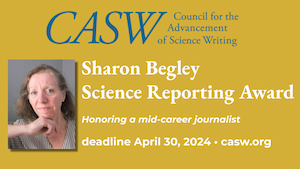By Kate Shaw
Every science writer has probably been experienced the same problem at one point or another: you've stumbled upon a great topic, but it isn't a story. How do you find a good angle and a narrative arc that will help you craft a story that readers won't want to put down?
In a packed room, four panelists in the "Unearthing narrative" session — George Johnson, Christie Aschwanden, David Quammen, and Eric Powell — discussed how they weave narrative into their stories, and how to handle the tricky situations where you just can't figure out how to make a story work.
Sometimes, a story's narrative just falls naturally into place. For example, two of George Johnson's book topics had obvious structures; a biography of physicist Murray Gell-Mann called for an intimate biographical approach, and for the Ten Most Beautiful Experiments, an ordered structure was the natural choice. But what do you do when the answer isn't so clear-cut?
Christie Aschwanden advised the audience to look for new perspectives on a difficult topic, especially if you are particularly close to your subject matter. Keep digging, keep making phone calls, and ask yourself what your audience would want to know. Eventually you will find a character, a point of view, or a new fact that will help you see things from a fresh and different angle.
According to David Quammen, "people like to read about people." He proposed a four-point plan to get colorful, personal stories from subjects: try to transcend the conventional journalist-scientist relationship, don't write about famous people, get out into the field and try to experience a non-lethal disaster with your subject, and experience serendipity (just don't ask him how).
If a standard narrative won't work, Eric Powell suggested that it may pay to look in non-traditional places for a creative angle. When one of his writers struggled with a narrative for a piece about the history of chocolate, Powell encouraged him to use the cacao tree as the main "character" to move the story along, and the piece quickly fell into place.
In response to an audience question, the panel discussed the use of first person. Sometimes it's essential to the story, if you have an interesting relationship with a character or if including yourself in the story will help disclose important information. However, if your presence doesn't move the story along, it's best to stay out of the piece, since the bar for first-person stories is particularly high.
The panelists all agreed that getting interesting anecdotes and details from scientists can sometimes be difficult. They suggested just letting researchers give their talking points, if that's what they seem to want to do. Once they have finished, start asking questions; they may let their guard down once they feel that they've made their point.
Finally, David Quammen added a final point to his four- (now five-) point plan: if all else fails, sharing a campfire and a bottle of scotch with a reticent scientist can work wonders.
Another view from Angela Herring
.png)

